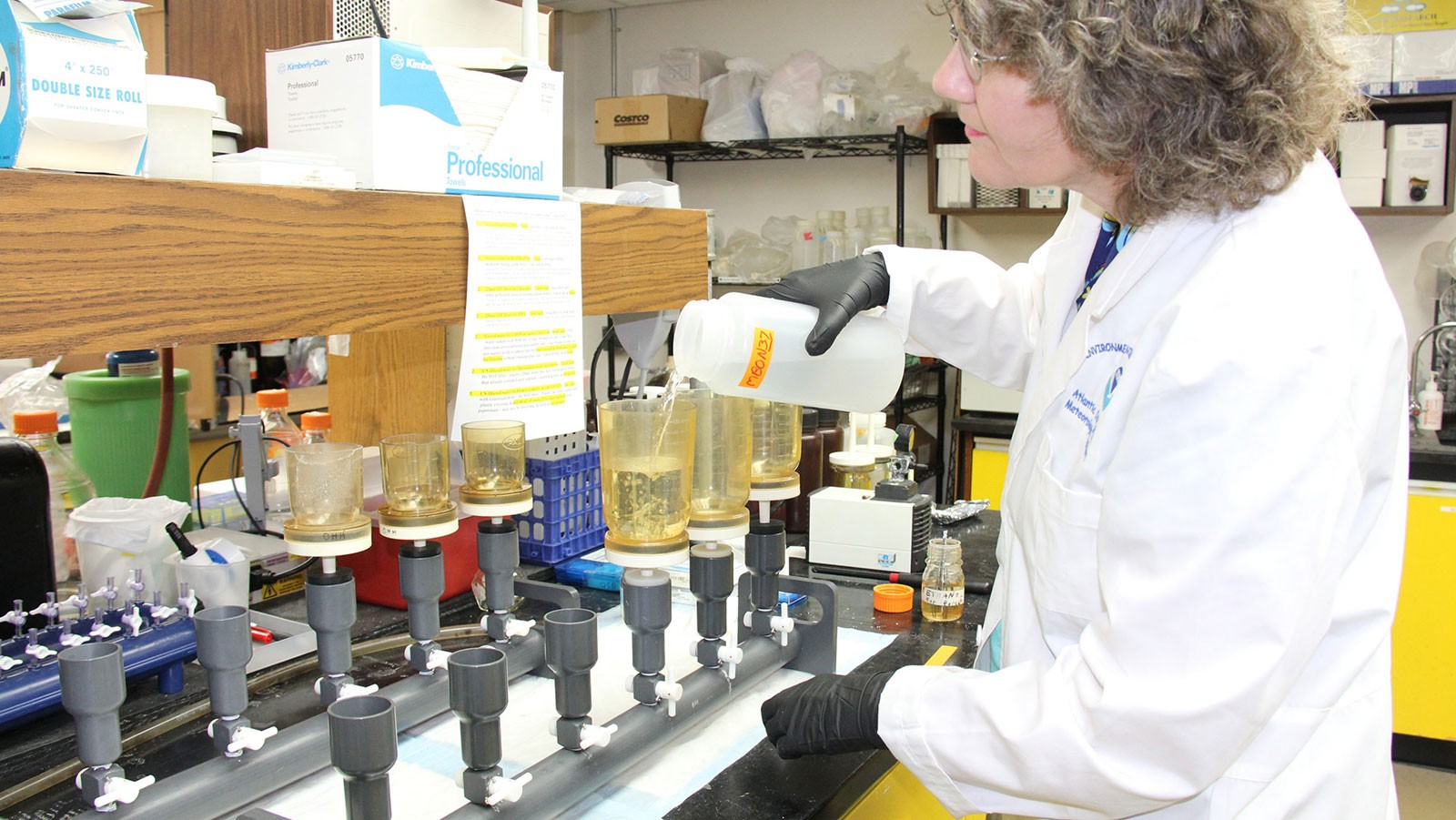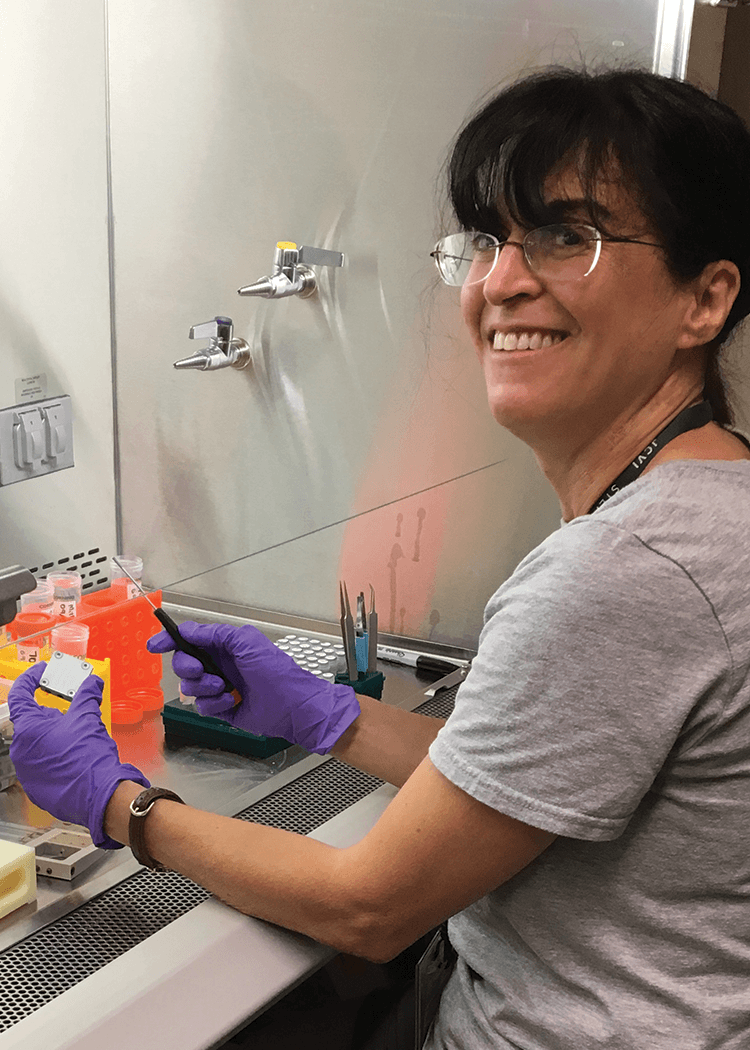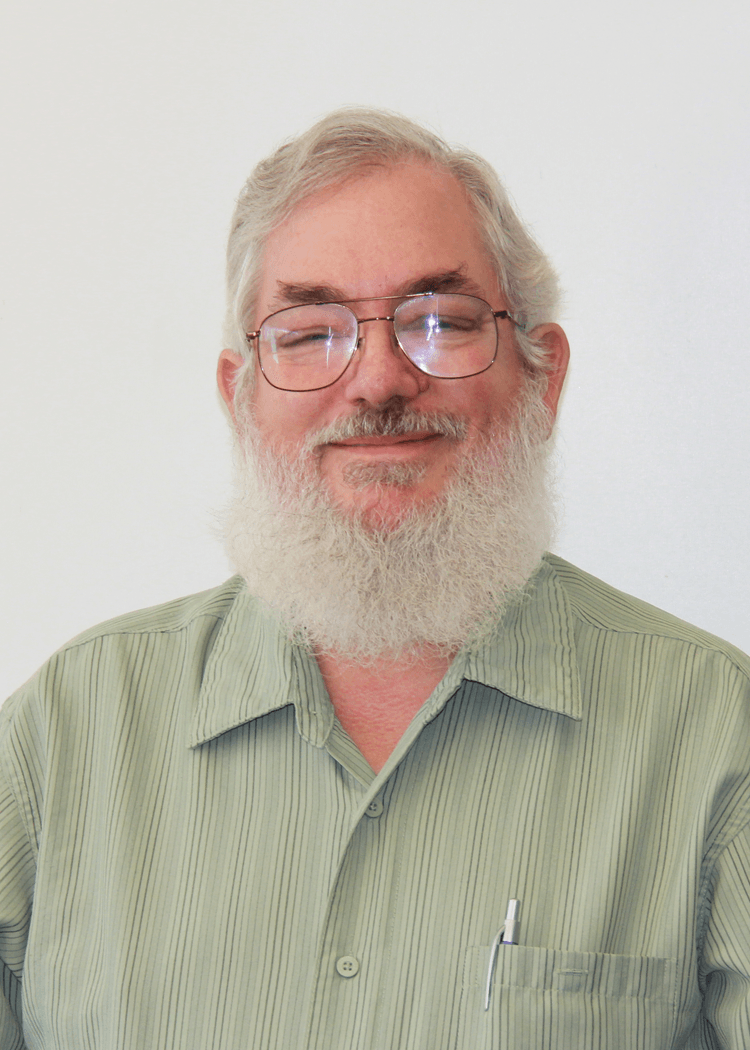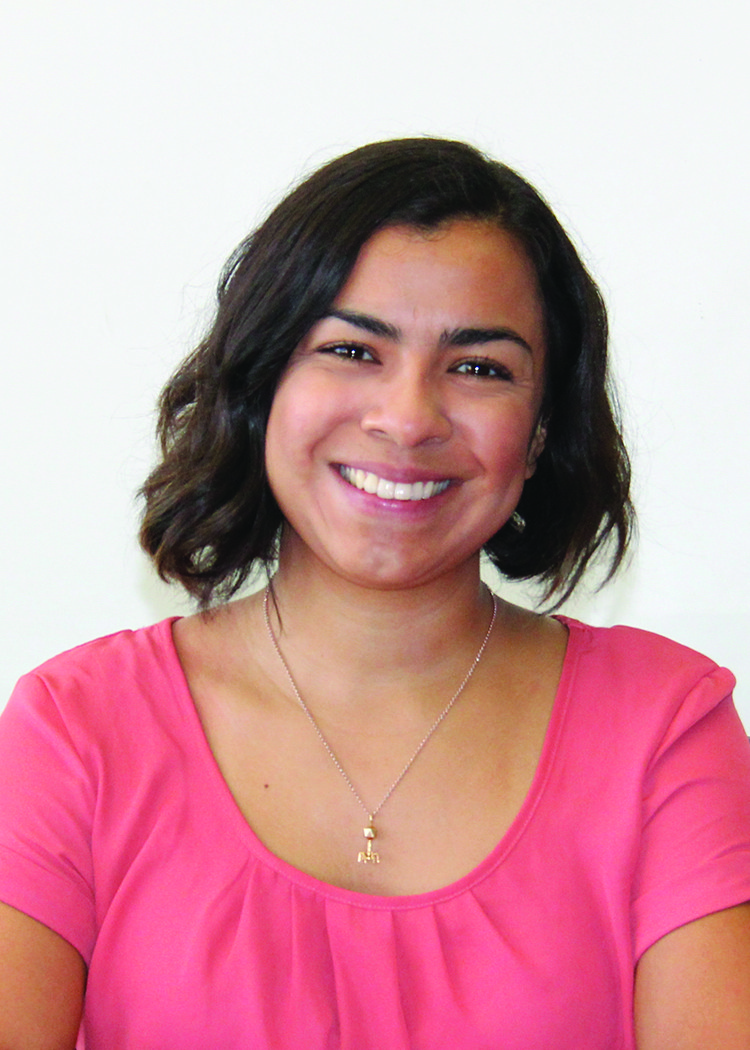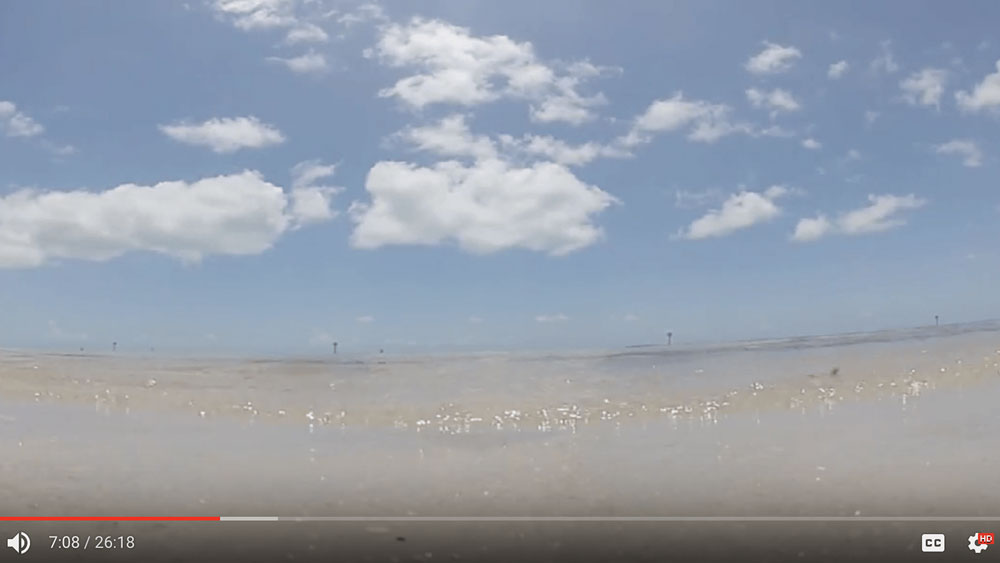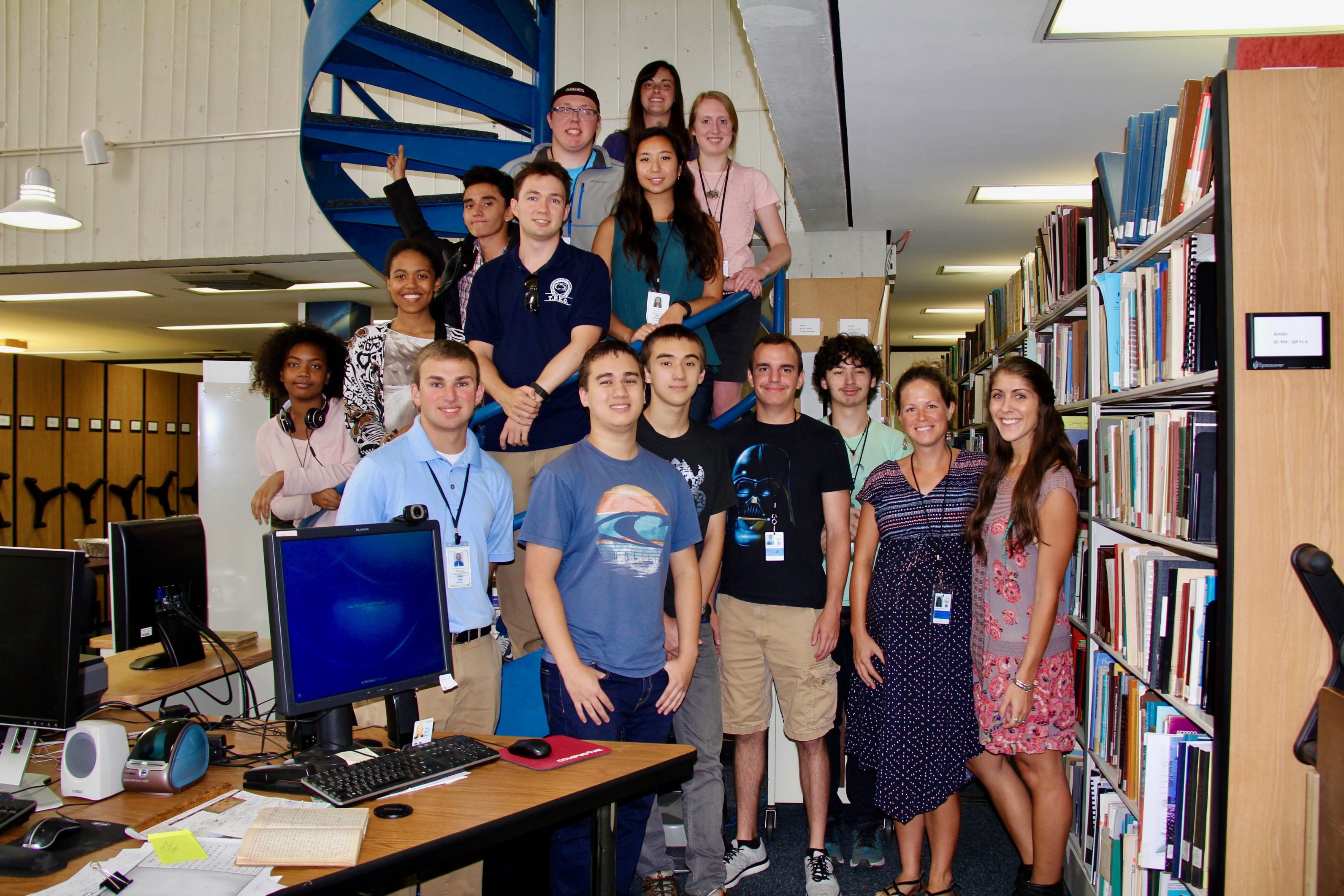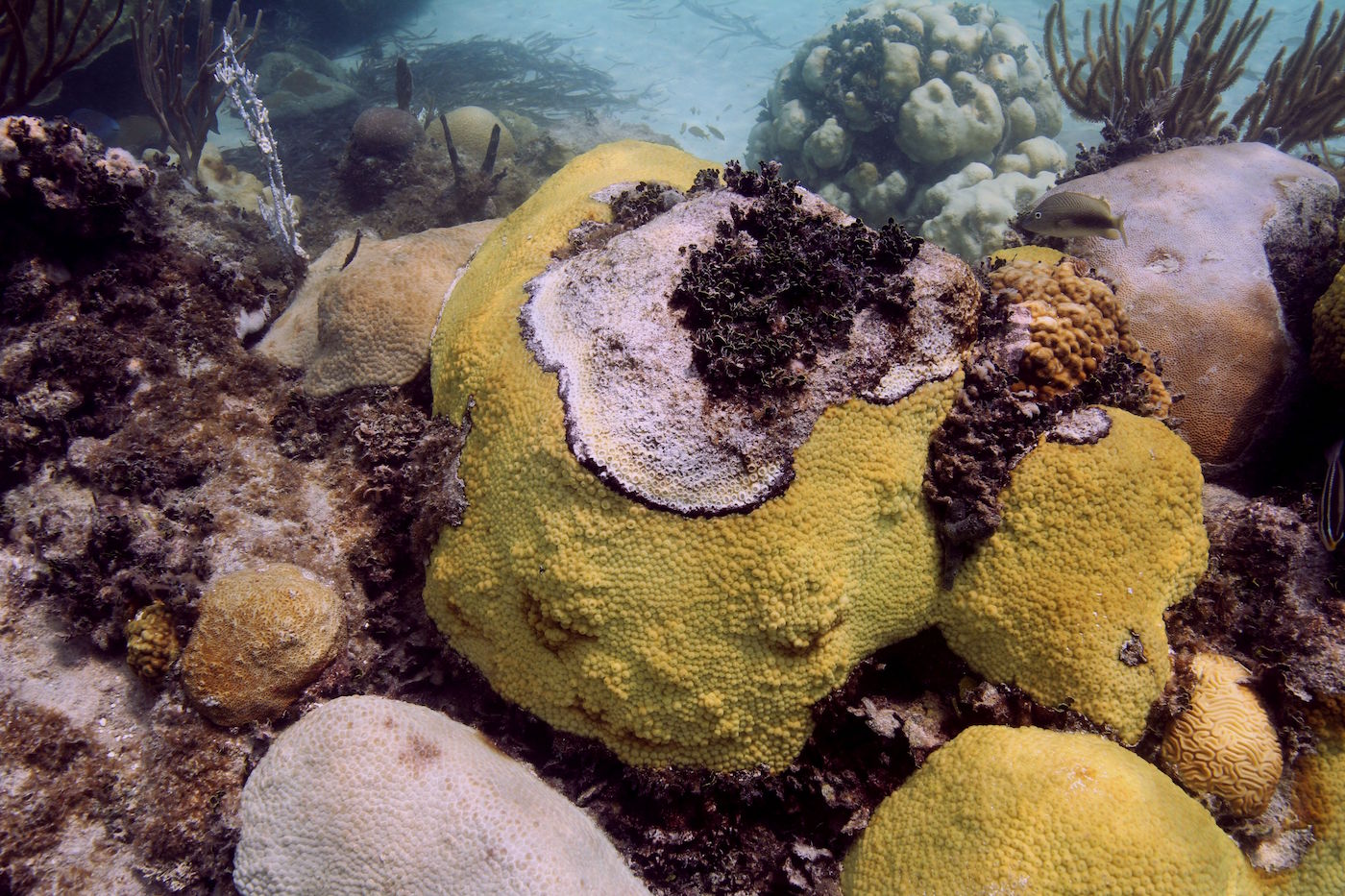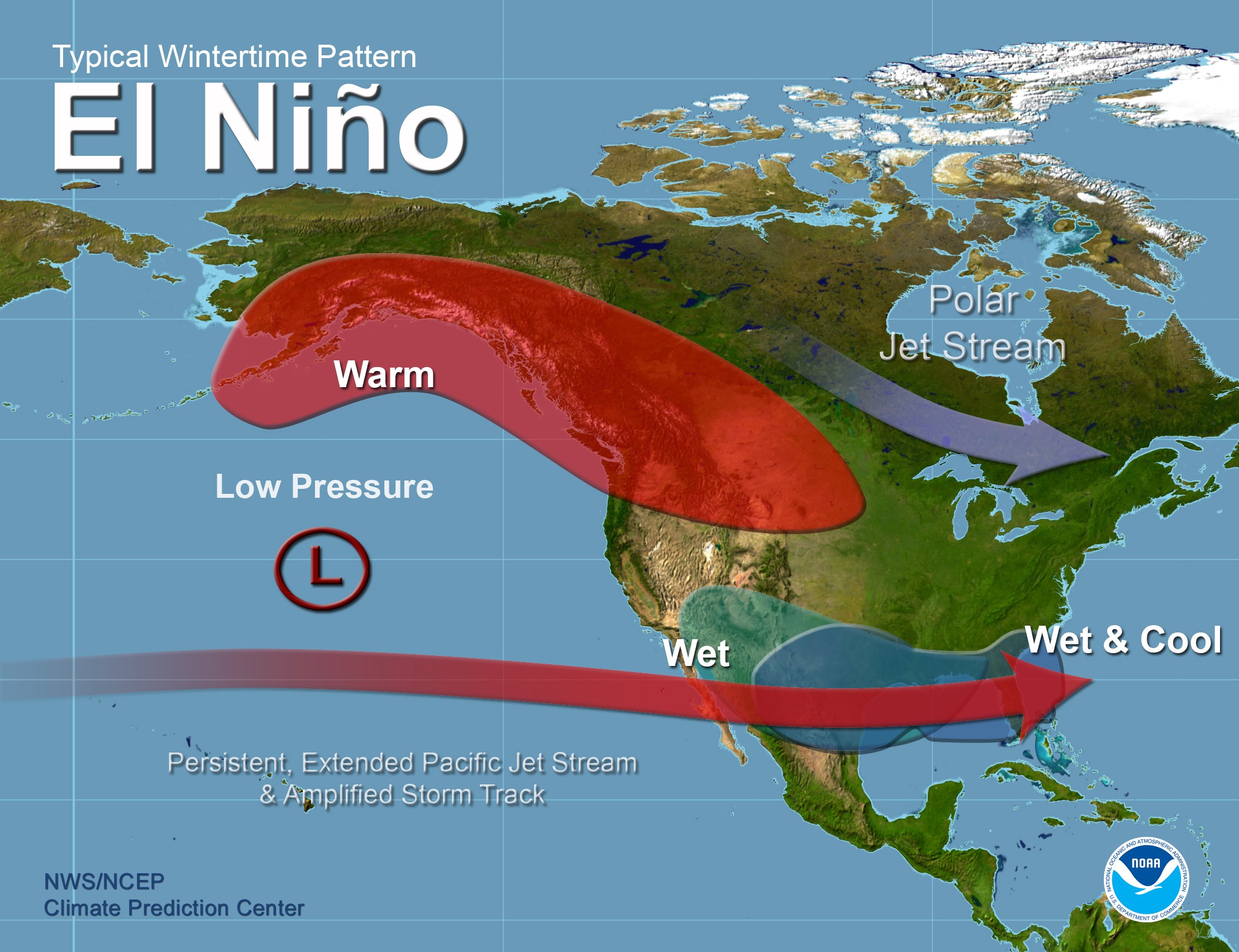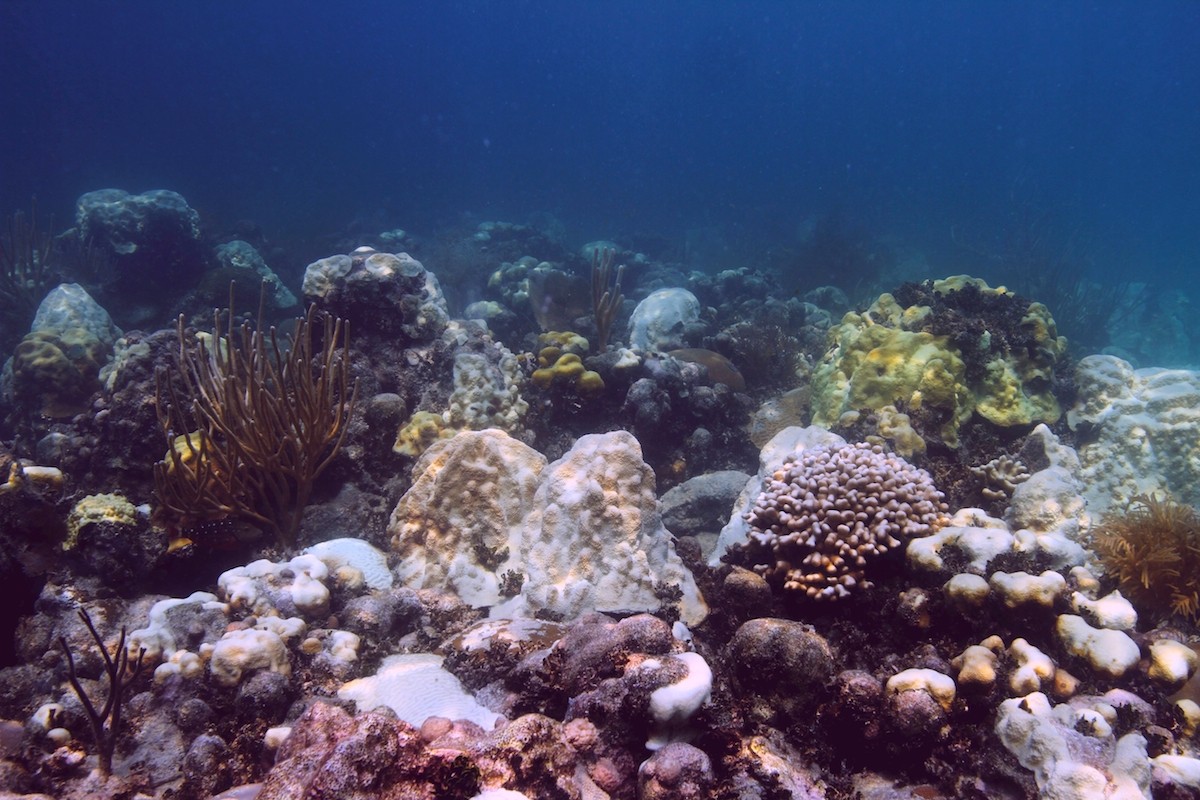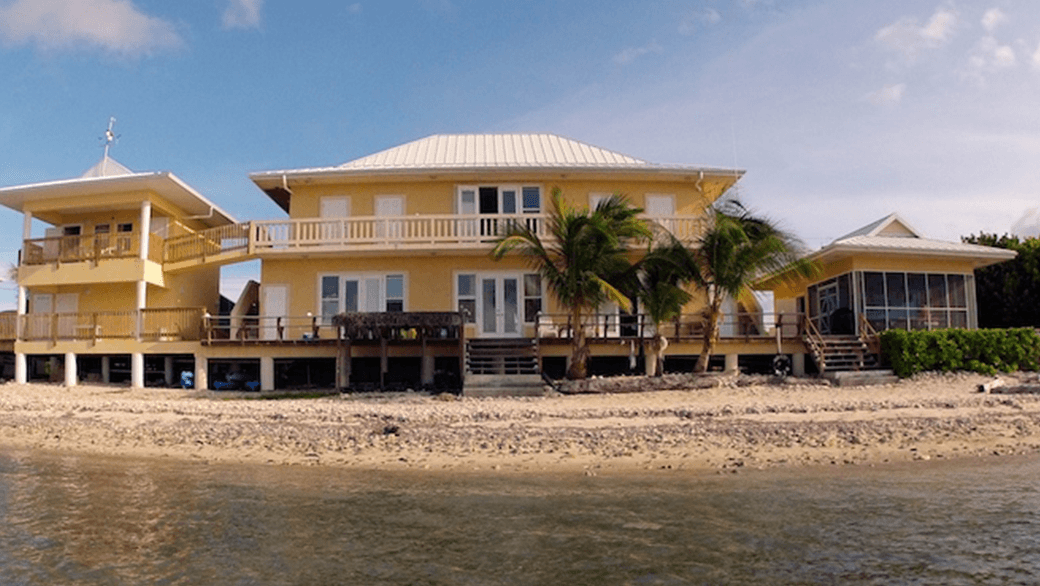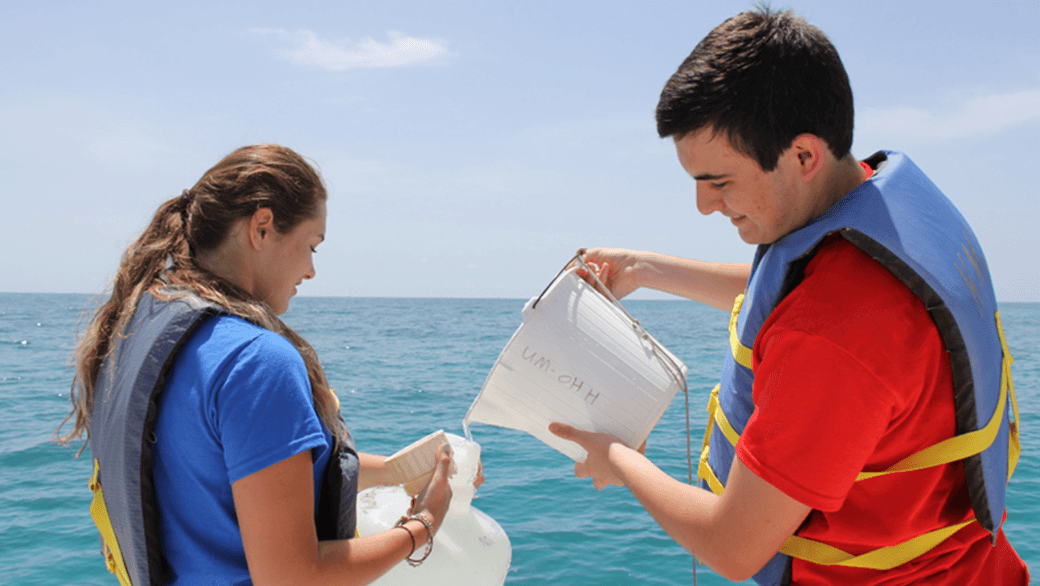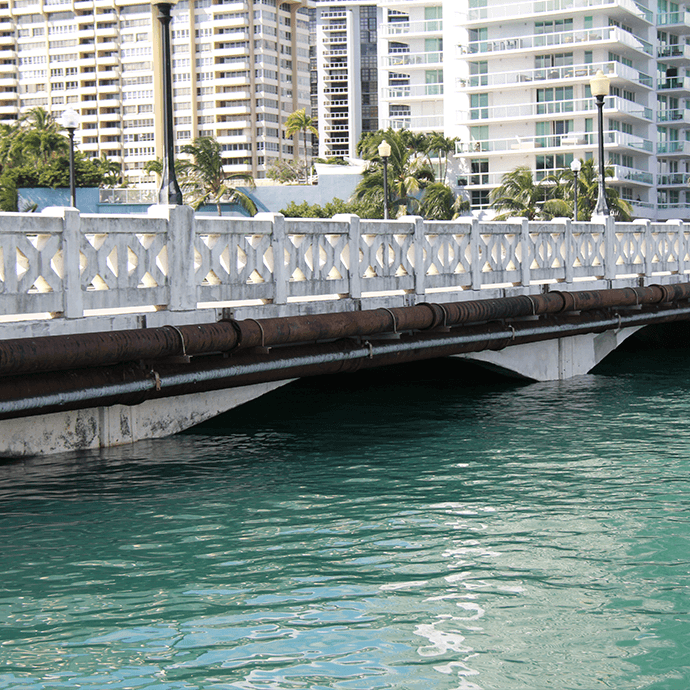Our Lab
The Environmental Microbiology Lab at AOML supports a highly collaborative multi-disciplinary research group that investigates the distribution, physiology, ecology, community structure, and function of microorganisms in the coastal and oceanic environment, and studies the interactions of these microbial communities with marine ecosystems and with humans.
Microbes help control the flow of energy and matter on our planet. Microbes can also degrade water quality and cause infections in humans, protected species, and critical habitats, such as coral. We investigate the mechanisms of this harm and work to understand and minimize the impact for both the environment and human health.
| Kelly Goodwin
Principal Investigator
| Christopher Singalliano
Principal Investigator, Environmental Microbiology
| Maribeth Gidley
CIMAS Research Scientist, Environmental Public Health
| Stephanie Rosalas
CIMAS Postdoctoral Associate, Bioinformatics
What We Do
AOML’s Environmental Microbiology Lab allows researchers to use traditional microbiology and cutting-edge molecular techniques to support a variety of projects. Scientists working in this lab focus on coastal water quality and the microbiological inter-relationships between ecosystem health and human health. The Environmental Microbiology Lab supports the following research goals:
- Provide new understanding of biodiversity to aid exploration and stewardship for marine and coastal resources
- Improve evaluation of baseline and changed ecosystem function
- Help stakeholders manage and mitigate contamination issues to protect health and economies
- Develop and validate new methods and technologies to improve molecular capabilities
- Provide research mentorship and training to the next generation of the nation’s environmental research workforce
The research activities conducted in the Environmental Microbiology lab help address the NOAA mission goal of Healthy Oceans and Resilient Coastal Communities and Economies by improving the capability to measure and understand the sources of degradation in coastal ecosystems and their impact on ecosystem health and resilience including the relationship of the oceans to human health. This work also enhances and increases the incorporation of science into ecosystem restoration and ecosystem-based management decisions.
Research Projects
Featured in Waterways: Beach Pathogen Project
Few accessible places represent Earth’s natural beauty quite like our beaches, but looks can be deceiving if there is a bacterial outbreak or contamination from offshore activities. Not being able to see these contaminants puts families at risk of exposure if they aren’t properly warned. The BEACHES project (Beach Exposure And Child Health Study), a collaboration between the University of Miami’s College of Engineering and the Cooperative Institute for Marine and Atmospheric Studies and AOML, along with the Universities of Arkansas and Texas, aims to pair child behavioral science with microbiology to address exposure risk of beachgoers. Learn more in the video, or by reading the Blog Post.
Our Stories
Publications
Publication List (Since 2002)
Click here to See All
Performance evaluation of canine-associated Bacterioidales assays in a multi-laboratory comparison study. A. Schriewer, C.D. Sinigallinao, K.D. Goodwin, A. Cox, D. Wanless, J. Bartkowiak, D.L. Ebentier, K.T. Hanley, J. Ervin, L.A. Deering, O.C. Shanks, L.A. Peed, W.G. Meijer, J. Griffith, J. Santo Domingo, J.A. Jay, P.A. Holden, and S. Wuertz. Water Research, submitted (2013).Performance of Human Fecal Anaerobe-Associated PCR-Based Assays in a Multi-Laboratory Method Evaluation Study. B.A. Layton, Y. Cao, D.L. Ebentier, K. Hanley L.C. Van De Werfhorst, D. Wang, T. Madi, R. Whitman, M. Byappanahalli, E. Ballesté, W.G. Meijer, A. Schriewer, S. Wuertz, R. Converse, R. Noble, S. Srinivasan, J.B. Rose, C.S. Lee, J. Lee, J. Gentry-Shields, J. Stewart, G.H. Reischer, A.H. Farnleitner, M.L. Gidley, C.D. Sinigalliano, J. Brandão, R. Rodrigues, S. Lozach, M. Gourmelon, L. Peed, J.A. Jay, P.A. Holden, A.B. Boehm; O.C. Shanks; J.F. Griffith. Water Research, in press (2013).
Microbial source tracking: State of the science and future directions. J. Stewart,J., A.B. Boehm, E.A. Dubinsky, T.-T. Fong, K.D. Goodwin, J.F. Griffith, K. Vijayavel, R.T. Noble, O.C. Shanks, and S.B. Weisberg. Water Research, in press (2013).
Multi-Laboratory Evaluations of the Performance of Catellicoccus marimammalium PCR Assays Developed to Target Gull Fecal Sources. C.D. Sinigalliano, J. Ervin, L.C. Van de Werfhorst, D. Wang, D. Wanless, J. Bartkowiak, B. Layton, M. Raith, A.B.B. Schriewer, C. Lee, K. D. Goodwin, J. Lee, A.B. Boehm, R. Noble, P.A. Holden, J. A. Jay, S. Wuertz, M. Byappanhalli, R. Whitman, M.J. Sadowsky, W. G. Meijer, E. Balleste, M. Gourmelon, J.F. Griffith, H. Ryu, and J.W. Santo Domingo. Water Research, in press (2013).
Evaluation of the repeatability and reproducibility of a suite of PCR-based microbial source tracking methods. D.L. Ebentier, K.T. Hanley, Y. Cao, B. Badgley, A. Boehm, J. Ervin, K.D. Goodwin, M. Gourmelon, J. Griffith, P. Holden, C.A. Kelthy, S. Lozach, C. McGhee, L. Peed, M. Raith, M.J. Sadowsky, E. Scott, J. Santo Domingo, C. Sinigalliano, O. Shanks, L.C. Van de Werfhorst, D. Wan, S. Wuertz and J. Jay. Water Research, in press (2013).
A.M. Cox and K.D. Goodwin. Analysis of sample preparation methods for quantitative detection of DNA by molecular assays and marine biosensors. Environmental Pollution Bulletin, submitted (2013).
Interlaboratory comparison of real-time PCR protocols for quantification of general fecal indicator bacteria. Shanks OC, Sivaganesan M, Peed L, Kelty CA, Blackwood AD, Greene MR, Noble RT, Bushon RN, Stelzer EA, Kinzelman J, Anan?eva T, Sinigalliano C, Wanless D, Griffith J, Cao Y, Weisberg S, Harwood VJ, Staley C, Oshima KH, Varma M, Haugland RA. Environmental Science and Technology. 46: 945-953 (2012).
A multi-beach study of Staphylococcus aureus, MRSA, and enterocci in seawater and beach sand. K.D. Goodwin, M. McNay, Y. Cao, D. Ebentier, M. Madison, and J. F. Griffith. Water Research, 46(13): 4195-207. Epub 21-APR-2012. 10.1016/j.watres.2012.04.001 (2012).
Occurrence and Persistence of Human Pathogens and Indicator Organisms in beach sands along the California Coast. K. Yamahara, L. Sassoubre, K.D. Goodwin and A. Boehm. Applied and Environmental Microbiology, 78(6):1733-1745 (2012).
New USEPA Water Quality Criteria by 2012: Gulf of Mexico Alliance concerns and recommendations. J. Gooch-Moore, K.D. Goodwin, C. Dorsey, R.D. Ellender, J.B. Mott, M. Ornelas, C. Sinigalliano, B. Vincent, D. Whiting. S.H. Wolfe Journal of Water and Health, 9(4), 718-733, http://www.iwaponline.com/jwh/up/wh2011156.htm (2011).
Microbial Source Tracking in Beaches and Coastal Environments. Solo-Gabriele HM, Boehm AB, Scott TM, Sinigalliano CD. In: Microbial Source Tracking: Methods, Applications, and Case Studies, 1st Edition; Section IX: Case Studies; Chapter 21: Beaches and Coastal Environments. Hagedorn E, Blanch A. Harwood VJ (eds.). Springer Press. pp 451-484. (2011).
Indicator microbes correlate with pathogenic bacteria, yeast, and helminthes in sand at a subtropical recreational beach site. Shah AH, Abdelzaher AM, Phillips M, Hernandez R, Solo-Gabriele HM, Kish J, Scorzetti G, Fell JW, Diaz MR, Scott, TM, Lukasik J, Harwood VJ, McQuaig S, Sinigalliano CD, Gidley ML, Wanless D, Agar A, Lui J, Stewart JR, Plano LRW, Fleming LE. Journal of Applied Microbiology. 110:1571-1583 (2011).
Daily measures of microbes and human health at a non-point source marine beach. Abdelzaher AM, Wright ME, Ortega C, Rasem Hasan A, Shibata T, Solo-Gabriele M, Kish J, Withum K, He G, Elmir SM, Bonilla JA, Bonilla TD, Palmer, CJ, Scott TM, Lukasik J, Harwood VJ, McQuaig S, Sinigalliano CD, Gidley, ML, Wanless D, Plano, LRW, Garza, AC, Zhu X, Stewart JR, Dickerson JW, Yampara-Iquise H, Carson C, Fleisher JM, Fleming LE. Journal of Water and Health. 9:443-457. (2011).
Shedding of Staphylococcus aureus and Methicillin-Resistant Staphylococcus aureus from Adult and Pediatric Bathers in Marine Waters. Plano LRW, Garza A, Shibata T, Elmir S, Kish J, Sinigalliano CD, Gidley ML, Miller G, Withum K, Fleming LE, Solo¬Gabriele H. BMC Microbiology 11(1):5. (2011).
Bacterial uptake of atmospheric carbon tetrachloride in bulk aerobic soils. Y. Mendoza, K. Goodwin and J.D. Happell. Applied and Environmental Microbiology, 77(17), 5835-5841 (2011).
Pathogen occurrence and distribution in tropical coastal streams as related to fecal indicators and land use. E.J. Viau, K.D. Goodwin, K. Yamahara, L. Sassoubre, B. Layton, Y. Lu and A. Boehm. Water Research, 45(11), 3279-3290 (2011).
Boynton-Delray Coastal Water Quality Monitoring Program. T. Carsey, C. Featherstone, K. Goodwin, C. Sinigalliano, J. Stamates, J.-Z. Zhang, J. Proni, J. Bishop, C. Brown, M. Adler, P. Blackwelder, H. Alsayegh. NOAA Technical Report, OAR AOML-39. August 2011. National Oceanic and Atmospheric Administration.
Molecular detection of harmful algal blooms (HABs) using locked nucleic acids and bead array technology. M.R. Diaz, J.W. Jacobson, K.D. Goodwin, J.W. Fell, S.A. Dunbar. Submitted.
FACE outfalls survey cruise – October 6-19, 2006. Carsey, T.P., H. Casanova, C. Drayer, C. Featherstone, C. Fischer, K. Goodwin, J. Proni, A. Saied, C. Sinigalliano, J. Stamates, P. Swart, and J.-Z. Zhang. NOAA Technical Report, OAR AOML-38, 130 pp. (CD-ROM) (2010).
Evaluation of conventional and alternative monitoring methods for a recreational marine beach with non-point source of fecal contamination. Shibata, T., Solo-Gabriele, H.M., Sinigalliano, C.D., Gidley, M.B., Plano, L.R., Fleisher, J., Wang, J., Elmir, S., He, G., Wright, M., Abdelzaher, A., Ortega, C., Wanless, D., Garza, A, Kish, J., Scott, T., Hollenbeck, J., Backer, L.C., Fleming, L.E. Environmental Science & Technology. 44(21):8175-81. (2010).
Traditional and Molecular Analyses for Fecal Indicator Bacteria in Non-point Source Subtropical Recreational Marine Waters. Sinigalliano, CD, Fleisher, J.M., Gidley, M.L., Solo-Gabriele, H.M., Shibata, T., Plano, L.R., Elmir, S.M., Wanless, D., Bartkowiak. J.,Boiteaua, R., Withum, K., Abdelzaher, A.M., He, G., Ortega, C., Zhub, X, Wright, M.E., Kish, J., Hollenbeck, J., Backer, L.C., Fleming, L.E. Water Research. 44:3763-3772. (2010).
The BEACHES Study: Health effects and exposures from nonpoint source microbial contaminants in subtropical recreational marine waters. Fleisher, J.M., L.E. Fleming, H.M. Solo-Gabriele, J.K. Kish, C.D. Sinigalliano, L.W. Plano, S.M. Elmir, J.D. Wang, K.F. Withum, T. Shibata, M.L. Gidley, A. Abdelzaher, G. He, C. Ortega, X. Zhu, M.D. Wright, J.A. Hollenbeck, and L.C. Backer. International Journal of Epidemiology, 39:1291-1298. (2010).
Presence of pathogens and indicator microbes at a non-point-source subtropical recreational marine beach. Abdelzaher, A., Wright, M., Ortega, C. Solo-Gabriele, H., Miller, G. Elmir, S., Newman, X., Shih, P., Bonilla, T.D., Palmer, C.J., Scott, T., Lukasik, J., Harwood, V.J., McQuaig, S., Sinigalliano, C., Gidley, M., Plano, L., Zhu, X., Wang, J.D., Fleming, L. Applied and Environmental Microbiology 76(3): 724-732. (2010).
Quantitative Evaluation of Enterococci and Bacteroidales Released by Adults and Toddlers in Marine Water. Elmir SM, Shibata T, Solo-Gabriele HM, Sinigalliano CD, Gidley ML, Miller G, Plano L, Kish J, Withum K, Fleming LE. Water Research Journal Vol. 43, Issue 18, 4610 ? 4616. (PMID: 19646730). (2009).
Pepper mild mottle virus as an indicator of fecal pollution. Rosario K, Symonds EM, Sinigalliano C, Stewart J, Breitbart M. Appl. Environ. Microbiol. 75:7261-7267. (2009).
Viable cell sorting of dinoflagellates by multi-parametric flow cytometry. Sinigalliano, C.D., J. Winshell, M.A. Guerrero, G. Scorzetti, J.W. Fell, R.W. Eaton, L. Brand, and K.S. Rein. Phycologia. 48: 249?257. (2009).
Performance of CHROMagar™ Staph aureus and CHROMagar™ MRSA for detection of Staphylococcus aureus in beach water and sand – comparison of culture, agglutination, and molecular analyses. K.D. Goodwin and M. Pobuda. Water Research, doi:10.1016/j.watres.2009.06.025 (2009).
Faecal indicator bacteria enumeration in beach sand: a comparison study of extraction methods in medium to coarse sands. A.B. Boehm, J. Griffith, C. McGee, T.A. Edge, H.M. Solo-Gabriele, R. Whitman, Y. Tsao, M. Getrich, J.A. Jay, D. Ferguson, K.D. Goodwin, C.M. Lee, M. Madison, and S.B. Weisberg. Journal of Applied Microbiology (2009).
A preliminary investigation of fecal indicator bacteria, human pathogens, and source tracking markers in beach water and sand. K.D. Goodwin, L. Matragano, D. Wanless, C. Sinigalliano, M.J. LaGier. Environmental Research Journal, 2(4):395-417, pp. 255-277 (2009).
A glimpse of the Florida Area Coastal Environment (FACE) program. T. Carsey, K.D. Goodwin, J. Hendee, J.R. Proni, C. Sinigalliano, J. Stewart, J.-Z. Zhang, N. Amornthammarong, J. Craynock, S. Cummings, P. Dammann, C. Featherstone, J. Stamates, K. Sullivan. A Proceedings of the 11th International Coral Reef Symposium, Ft. Lauderdale, Florida, 7-11 July 2008 (2009).
Emerging technologies for monitoring recreational waters for bacteria and viruses. K.D. Goodwin and R.W. Litaker. IN: Oceans and Human Health: Risk and Remedies from the Seas. P.J. Walsh, S.L. Smith, W.H. Gerwick, H. Solo-Gabriele, L. Fleming, eds. Academic Press, New York, pp. 381-404, ISBN-13: 978-0123725844 (2008).
The coastal environment and human health: Microbial indicators, pathogens, sentinels and reservoirs. Stewart, J.R., R.J. Gast, R.S. Fujioka, H.M. Solo-Gabriele, J.S. Meschke, L.A. Amaral-Zettler, E.Del Castillo, M.F. Polz, T.K. Collier, M.S. Strom, C.D. Sinigalliano, P.D.R. Moeller, and A.F. Holland. Environmental Health. 7(Suppl 2):S3. (2008).
Multiple simultaneous detection of Harmful Algal Blooms (HABs) through a high throughput bead array technology, with potential use in phytoplankton community analysis. Scorzetti G., L.E. Brand, G.L. Hitchcock, K.S. Rein, C.D. Sinigalliano and J.W. Fell. Harmful Algae. 8(2):196-211. (2008).
Acoustic methods for water mass delineation in coastal marine ecosystems. Proni, J., J. Stamates, T. Carsey, J.-Z. Zhang, C.D. Sinigalliano, and K. Sullivan. J Acoust Soc Am. 2008 May; 123 (5):3212. (2008).
The future for monitoring. C.J. Palmer, T.D. Bonilla, J.A. Bonilla, S. Elmir, K.D. Goodwin, H.M. Solo Gabriele, and A. Abdelzaher. IN: Oceans and Human Health: Risk and Remedies from the Seas. P.J. Walsh, S.L. Smith, W.H. Gerwick, H. Solo-Gabriele, L. Fleming, eds. Academic Press, New York, pp. 405-429, ISBN-13: 978-0123725844 (2008).
The possibility of false negative results hampers the ability to elucidate the relationship between fecal indicator bacteria and human pathogens and source tracking markers in beach water and sand. K.D. Goodwin, L. Matragano, D. Wanless, C. Sinigalliano, M.J. LaGier. IN: Marine Pollution: New Research. T.N. Hofer, ed. Nova Science Publishers, Inc., pp. 255-277, IBSN-13: 978-1604562422 (2008).
Salt aerosol and bioaerosol production from a sea-salt aerosol generator. D. Voss, H. Maring, K.D. Goodwin. IN: Marine Pollution: New Research. T.N. Hofer, ed. Nova Science Publishers, Inc., pp. 399-429, IBSN-13: 978-1604562422 (2008).
Electrochemical detection of harmful algae and other microbial contaminants in coastal waters using hand-held biosensors. M.J. LaGier, J.W. Fell, and K.D. Goodwin. Marine Pollution Bulletin, doi:10.1016/j.marpolbul.2006.12.017, 54:757-770 (2007).
Luminex detection of fecal indicators in river samples, marine recreational water, and beach sand. I.B. Baums, K.D. Goodwin, T. Kiesling, D. Wanless, M. Diaz, and J.W. Fell. Marine Pollution Bulletin, doi:10.1016/j.marpolbul.2006.12.018, 54:521-536 (2007).
Impacts of Hurricanes Katrina and Rita on the microbial landscape of the New Orleans area. Sinigalliano, C.D., M.L. Gidley, T. Shibata, D. Whitman, T.H. Dixon, E. Laws, A. Hou, D. Bachoon, L. Brand, L. Amaral-Zettler, R.J. Gast, G.F. Steward, O.D. Nigro, R. Fujioka, W.Q. Betancourt, G. Vithanage, J. Mathews, L.E. Fleming, and H.M. Solo-Gabriele. Proc. Natl. Acad. Sci. 104(21):9029-9034. (2007).
Brevard County Near Shore Ocean Nutrification Analysis. T.P. Carsey, R. Ferry, K.D. Goodwin, P.B. Ortner, J. Proni, P.K. Swart, J.-Z. Zhang. NOAA Technical Memorandum, in press (2005).
Toluene inhibits methyl bromide biodegradation in seawater and isolation of a marine toluene-oxidizer that degrades methyl bromide. K.D. Goodwin, R. Tokarczyk, F.C. Stephens, and E.S. Saltzman, Applied and Environmental Microbiology, 71(7): 3495-3503 (2005).
A DNA hybridization assay to identify toxic dinoflagellates in coastal waters: detection of Karenia Brevis in the Rookery Bay National Estuarine Research Reserve. K.D. Goodwin, S.A. Cotton, G. Scorzetti, and J.W. Fell, Harmful Algae, 4: 411-422 (2005).
Localization of polyketide synthase encoding genes to the toxic dinoflagellates Karenia brevis. Snyder, R.V., Guerrero, M.A., Sinigalliano, C.D., Winshell, J., Perez, R., Lopez, J.V., and Rein, K.S. Phytochemistry 66:1767-1780. (2005).
Detection of Karenia brevis by a microtiter plate assay. K.D. Goodwin, G. Scorzetti, S.A. Cotton, T.L. Kiesling, P.B. Ortner, and J.W. Fell. IN: Harmful Algae 2002. Proceedings of the Xth International Conference on Harmful Algae. Steidinger, K.A., Landsberg, J.H. Tomas, C.R., and Vargo, G.A. (Eds.). Florida Fish and Wildlife Conservation Commission and Intergovernmental Oceanographic Commission of UNESCO (2004).
Methyl bromide and methyl chloride in the Southern Ocean. Yvon-Lewis, S.A., D.B. King, R. Tokarczyk, K.D. Goodwin, E.S. Saltzman, and J.H. Butler. Journal of Geophysical Research, 109, CO2008, doi:10.1029/2003JC001809 (2004).
Methyl chloride and methyl bromide degradation in the Southern Ocean. R. Tokarczyk, K.D. Goodwin, E.S. Saltzman. Geophysical Research Letters, 30(15): OCE 2-1-2-4, doi:10.1029/2003GL017459 (2003).
Bacterial degradation of trihalomethanes, Goodwin, K.D. In: M.S. Fram, B.A. Bergamaschi, K.D. Goodwin, R. Fujii, J.F. Clark, Processes affecting the trihalomethane concentrations associated with the subsurface injection, storage, and recovery program in Lancaster, Antelope Valley, California, U.S. Geological Survey Water-Resources Investigations Report, 03-4062,http://water.usgs.gov/pubs/wri/wri034062/ (2003).
Halocarbon biogeochemistry. L.G. Miller and K.D. Goodwin (editors). Biogeochemistry, special issue, 60, 92 pages (2002).
Water-Quality Monitoring and Studies of the Formation and Fate of Trihalomethanes during the Third Injection, Storage, and Recovery Test at Lancaster, Antelope Valley, California, March 1998 through April 1999. Fram, M.S., J.K. Berghouse, B.A. Bergamaschi, R. Fuji, K.D. Goodwin, and, J.F. Clark. U.S. Geological Survey Open File Report 02-102 (2002).
Leisingera methylohalidivorans gen. nov., sp. nov., a marine methylotroph that grows on methyl bromide . J.K. Schaefer, K.D. Goodwin, I.R. McDonald, J.C. Murrell, and R.S. Oremland. International Journal of Systematic and Evolutionary Microbiology, 52: 851-859 (2002).
